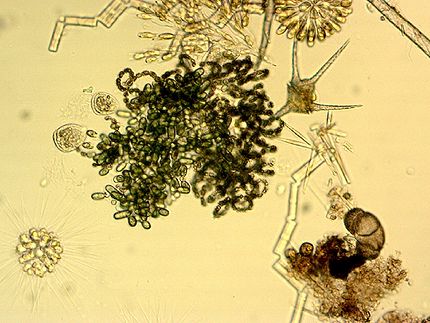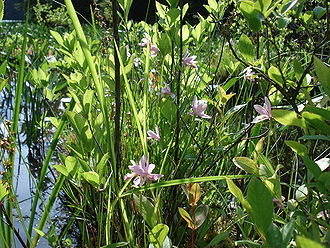THIS PROJECT IS CURRENTLY TRANSITIONING TO iNaturalist
click here for the current status of 'Freshwater Algae of New England'
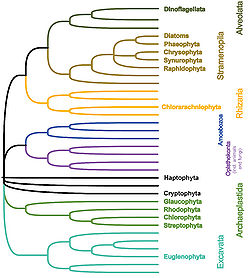
Simplified diagram of the eukaryotic tree of life highlighting lineages containing photosynthetic organisms - algae
Biodiversity hidden to the naked eye
Microorganisms are incredibly diverse. A small sample of water from a local pond can contain dozens of species - some related to plants, some related to fungi, and some belonging to completely different, ancient lineages of eukaryotes (see simplified eukaryotic tree of life above). Algae are a subset of this diversity: they are organisms that contain a photosynthetic organelle (plastid). Here are a few examples of the charismatic algae found in the vicinity of the University of Connecticut.
Click here to see the map of localities sampled so far
Current total: 161 species!
Many microscopic and macroscopic algae belong to the group called Stramenopiles (also referred to as heterokonts). Diatoms, Chrysophytes, and Synurophytes are microscopic, and Phaeophytes (kelps, or brown algae) are mostly macroscopic and marine.
Chrysophytes and Synurophytes
- Dinobryon is a colonial flagellated alga from the class Chrysophyceae. Another colonial chrysophyte is Uroglenopsis, also found in CT.
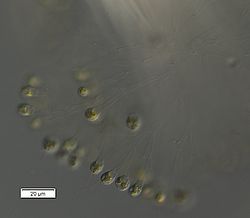 Uroglenopsis cf. americana from Middle Bolton Lake, Vernon, CT; video here |
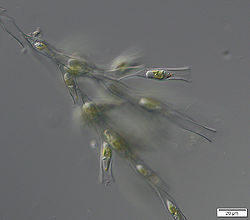 Dinobryon cf. cylindricum from Walker Reservoir, Vernon, CT |
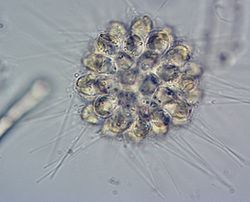 Chrysosphaerella longispina from Knowlton Pond, Ashford, CT |
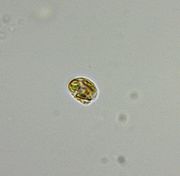 A tiny flagellate, possibly Ochromonas sp. from EEB greenhouse, Storrs, CT; video here |
- Synura is a genus of the Synurophyceae, the sister group of Chrysophyceae. Their plastids give members of both groups a typical golden-brown color. Synurophyceae have cells covered with siliceous scales and detailed examination of scale morphology is often needed for species identification. Colonies of Synura are not the most elegant of swimmers, but are fun to watch tumbling around.
- Mallomonas is a common solitary synurophyte. Its cells are also covered in scales and often equipped with long bristles attached to the scales. Note how large the cell is in comparison to the individual cells in the colony of Synura.
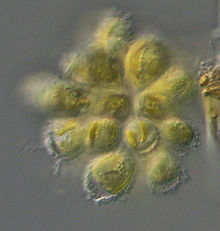 Synura cf. uvella from Walker Reservoir, Vernon, CT; video here |
 Synura cf. caroliniana from Breakneck Pond, Union, CT |
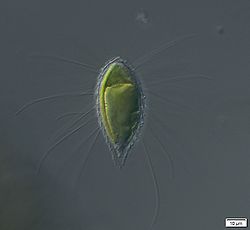 Mallomonas caudata from Bone Mill Pond, Storrs, CT |
Diatoms
- Diatoms (Bacillariophyceae) are very common not only in freshwater habitats, but also in marine environments. They can be solitary cells or form chains or stalked colonies. Their cells are enclosed in siliceous cases called frustules, which bear fine ornamentation best visible under high magnifications or under a scanning microscope. These fine structures of the frustules are used to identify diatom species.
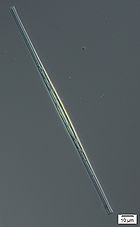 Nitzschia sp. from Mirror Lake, Storrs, CT |
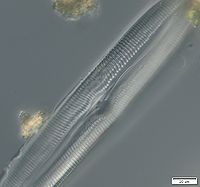 empty frustule of Pinnularia sp. from Tift Pond, Storrs, CT |
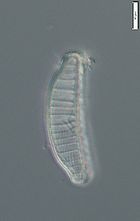 Epithemia sp. from Tift Pond, Storrs, CT |
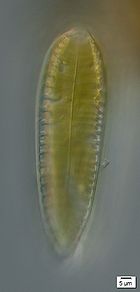 Surirella sp. from Tift Pond, Storrs, CT |
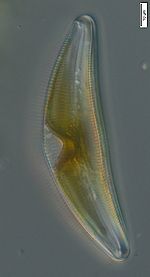 Cymbella sp. from Tift Pond, Storrs, CT |
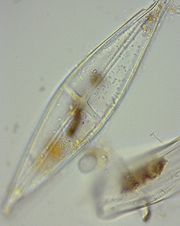 Stauroneis sp. from from Knowlton Pond, Ashford, CT |
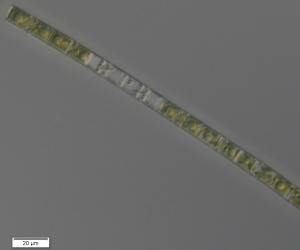 Melosira sp., a common chain-forming diatom from Middle Bolton Lake, Vernon, CT |
 Nitzschia sigma, a unicellular diatom from pond on Forest Rd., Mansfield, CT |
 Tabellaria sp., a common colony-forming diatom from Middle Bolton Lake, Vernon, CT |
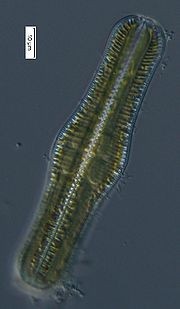 Rhopalodia gibba, a unicellular diatom from the EEB greenhouse, Storrs, CT |
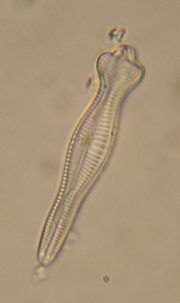 Gomphonema sp. from River Park, Tolland, CT |
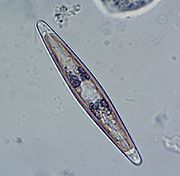 Navicula sp. from Knowlton Pond, Ashford, CT |
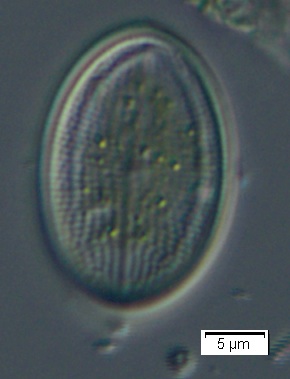 Cocconeis sp., a unicellular diatom from the EEB greenhouse, Storrs, CT |
 Gomphoneis sp. from stream by the Willington Pizza restaurant, Willington, CT |
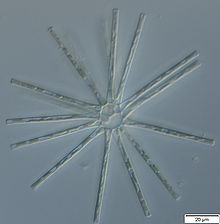 Asterionella sp. from Breakneck Pond, Union, CT |
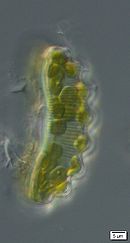 Eunotia serra from Breakneck Pond, Union, CT |
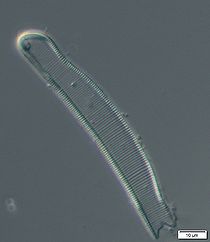 Eunotia sp. from Breakneck Pond, Union, CT |
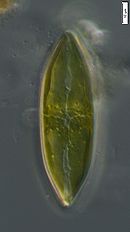 Neidium sp. from a marsh at Bigelow Hollow, Union, CT |
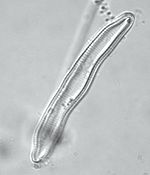 Eunotia pectinalis var. undulata from Knowlton Pond, Ashford, CT |
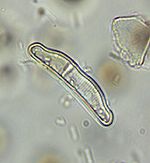 Eunotia sp. from stream by Nathaniel Lyon Memorial Park, Eastford, CT |
 Cymatopleura solea from Hillside Environmental Education Park, Storrs, CT |
Raphidophytes
- Gonyostomum is one of the few members of the small phylum Raphidophyta. It can form nuisance blooms.
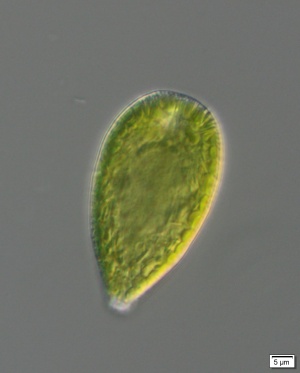 Gonyostomum semen from a wetland at Bigelow Hollow, Union, CT |
Cryptophytes
- Cryptophyta is an ancient lineage of photosynthetic eukaryotes. One of the few common species is the flagellate Cryptomonas, which can be found in most water bodies in CT.
 Cryptomonas sp. from a tank in the EEB greenhouse, Storrs, CT |
Dinoflagellates
Dinoflagellates are members of the Alveolata, a group related to the Stramenopiles. Ceratium and Peridinium are common freshwater genera.
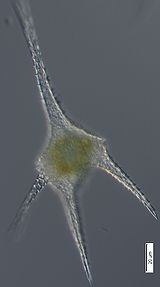 Ceratium hirundinella from Middle Bolton Lake, Vernon, CT |
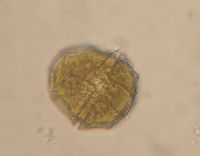 Peridinium cf. cinctum from Breakneck Pond, Union, CT |
 Parvodinium umbonatum from Breakneck Pond, Union, CT |
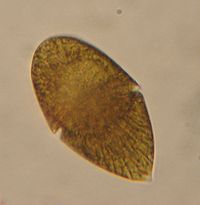 Gymnodinium sp. from wetland on Mansfield City Rd., Eagleville, CT |
 Peridinium aciculiferum from Brown Hill Marsh, Chaplin, CT |
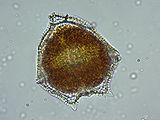 Peridinium limbatum from Shenipsit Lake, Ellington, CT |
Cyanobacteria
Some "algae" are not even eukaryotic - the photosynthetic Cyanobacteria (some of which gave rise to chloroplasts) are sometimes also referred to as "blue-green algae". They are morphologically diverse, ranging from unicellular to colonial to filamentous. They are very common and in some cases even form toxic blooms.
 Gloeothece sp. from the EEB greenhouse, Storrs, CT |
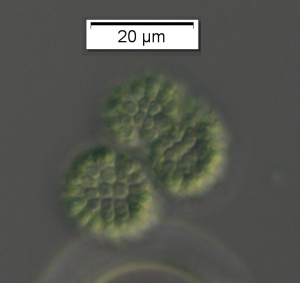 unidentified colonial cyanobacterium, possibly Snowella sp. from the pond on Forest Rd., Mansfield, CT |
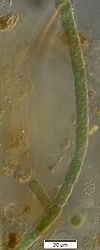 Hapalosiphon sp. from the pond on Eldredge Rd., Willington, CT |
 Oscillatoria sp. from the Cedar Swamp, Mansfield, CT |
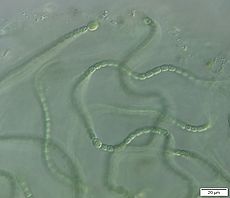 Nostoc sp., a colony-forming cyanobacterium from Breakneck Pond, Union, CT |
 Tolypothrix sp., a filamentous cyanobacterium and its characteristic "false branching"; from Breakneck Pond, Union, CT |
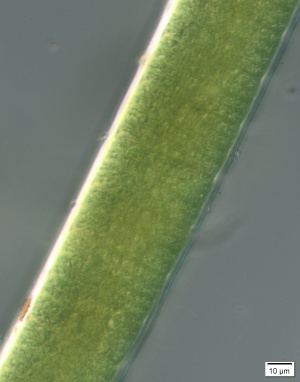 Lyngbya sp., a large sheathed filamentous cyanobacterium from Tift Pond, Storrs, CT |
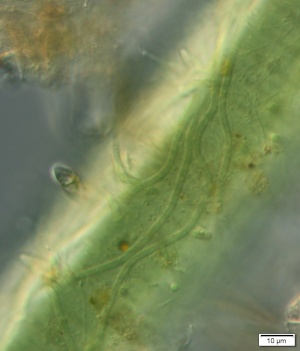 Leibleinia, a small filamentous cyanobacterium growing epiphytically on Lyngbya; Tift Pond, Storrs, CT |
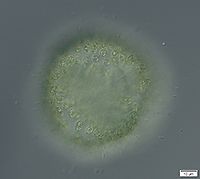 Woronichinia naegeliana a cyanobacterium forming compact, round, hollow colonies; Tift Pond, Storrs, CT |
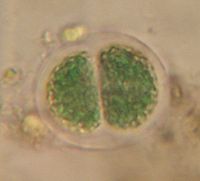 Chroococcus sp. from Pine Acres Lake, Hampton, CT |
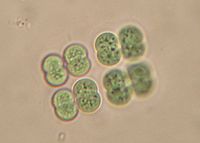 Merismopedia elegans from Pine Acres Lake, Hampton, CT |
Rhodophyta
Rhodophyta, or red algae, are common in marine habitats and are especially diverse in the tropics. Several of these macroscopic seaweeds are used for human consumption, e.g., Porphyra or nori is used for sushi wraps. There are freshwater rhodophytes, though, both microscopic and macroscopic. The branched filaments of Batrachospermum and Tuomeya are often found in small streams, while the unbranched, stiff and knobby filaments of Lemanea typically grow in tufts around dams. These algae are macroscopic but hard to find if you don't know what you are looking for. All three genera occur in Connecticut.
 Lemanea sp. from Eagleville Dam, Eagleville, CT |
 close-up of a dissected filament of Lemanea sp. from Eagleville Dam, Eagleville, CT |
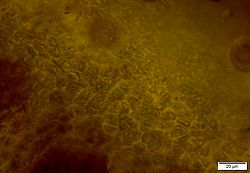 close-up of the surface of a Lemanea filament, showing corticating cells; Eagleville Dam, Eagleville, CT |
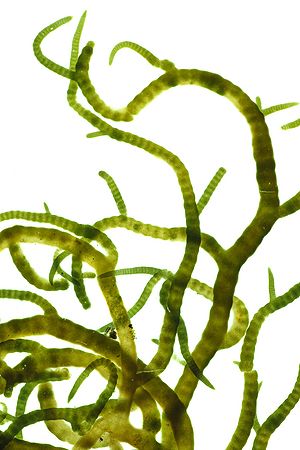 Tuomeya americana from Bigelow Brook, Ashford, CT; awesome photo taken by Ellen Woods |
 Tuomeya americana from Bigelow Brook, Ashford, CT |
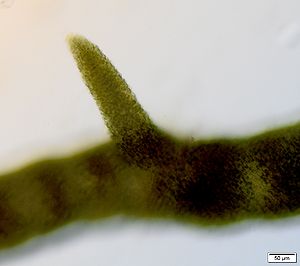 close-up of Tuomeya americana from Bigelow Brook, Ashford, CT |
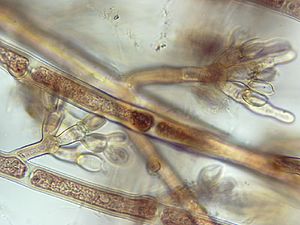 Audouinella cf. hermannii from Fenton River, Storrs, CT |
 Batrachospermum sp. from Hampton Reservoir, Hampton, CT |
Euglenoids
Euglenoids are an ancient lineage most closely related to Kinetoplastida (best known for the parasite Trypanosoma). They acquired photosynthetic abilities by engulfing a green alga - and therefore they may superficially resemble one. Among the commonly occurring genera are Euglena, Trachelomonas, and Phacus.
- Unlike green algae, which store energy in form of starch, euglenoids use a different carbohydrate, paramylon. The paramylon bodies are often large and of a white-ish, "shiny" appearance, like the one visible in the Phacus specimen below.
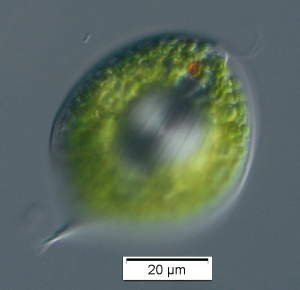 Phacus orbicularis from pond on Forest Rd., Mansfield, CT |
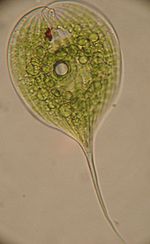 Phacus longicaudatus from River Park, Tolland, CT |
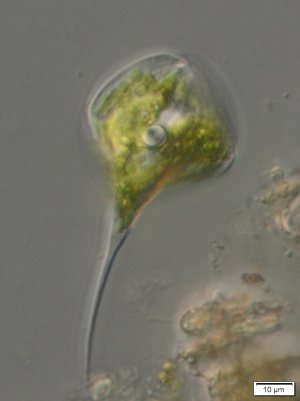 Phacus tortus from wetland on Mansfield City Rd., Eagleville, CT |
 Euglena sp. from Breakneck Pond, Union, CT; video of another Euglena species from Tift Pond here |
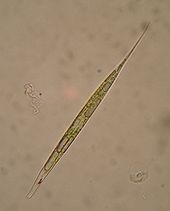 Euglena acus from wetland on Airline Trail North, Eastford, CT |
 Euglena spirogyra from wetland on Airline Trail North, Eastford, CT |
| |
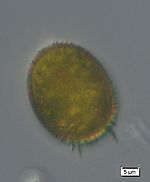 Trachelomonas armata var. steinii from Tift Pond, Storrs, CT |
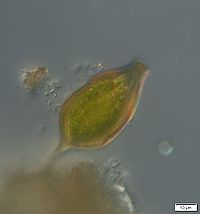 Strombomonas sp. from Tift Pond, Storrs, CT |
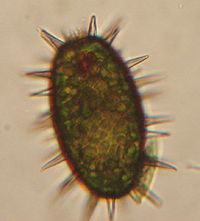 Trachelomonas cf. hystrix from wetland on Mansfield City Rd., Eagleville, CT |
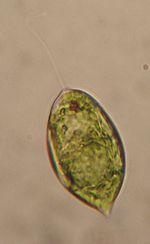 Lepocinclis ovum from wetland on Airline Trail North, Eastford, CT |
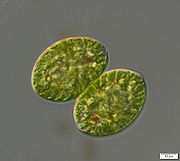 Lepocinclis texta from wetland on Mansfield City Rd., Eagleville, CT |
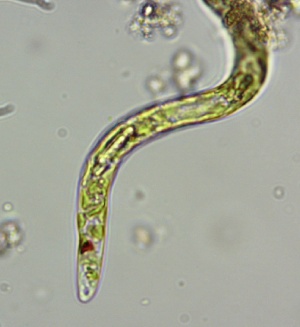 metabolic Euglena sp. from Barrows Academy pond, Windham, CT |
Green algae: Chlorophyta
- Some algae grow on plants or on other algae - epiphytically. Aphanochaete from the order Chaetophorales, is an example of a green filamentous alga growing on another green filamentous alga, Oedogonium (order Oedogoniales).
- Other free-living filamentous algae are Microspora, the branching Chaetophora, the above mentioned Oedogonium, and Bulbochaete - a relative of Oedogonium with branched filaments ending in long projections.
- Green algae often produce swimming cells as part of their life cycles. As an example, a video of a swimming cell of Oedogonium can be found here.
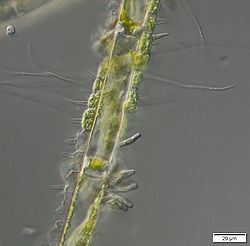 Aphanochaete repens growing epiphytically on Oedogonium; from Walker Reservoir, Vernon, CT |
 Chaetophora sp. from stream by the Willington Pizza restaurant, Willington, CT |
 Microspora sp. from stream by the Willington Pizza restaurant, Willington, CT |
|
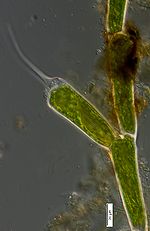 Bulbochaete sp. from pond on Forest Rd., Mansfield, CT |
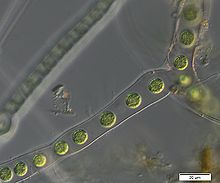 Palmodictyon varium, an unusual not-quite-filamentous green alga from Cedar Swamp/Rt. 195, Mansfield, CT |
 Stigeoclonium flagelliferum, a branching filamentous green alga related to Chaetophora and Aphanochaete; from Cedar Swamp/Rt. 195, Mansfield, CT |
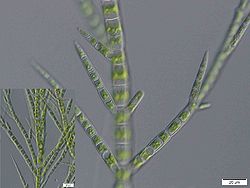 Stigeoclonium tenue from Eagleville Dam, Eagleville, CT; collection and photo by Nikolaus Schultz |
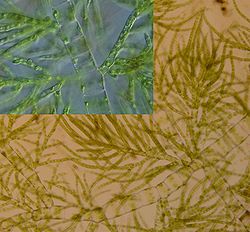 Draparnaldia plumosa, a charismatic filamentous alga from Eagleville Dam, Eagleville, CT; collection, photo, and video by Nikolaus Schultz |
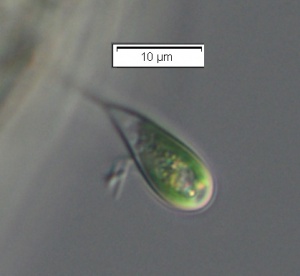 Characium sp., another epiphytic green alga, Cedar Swamp, Mansfield, CT |
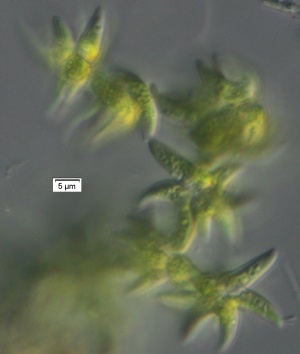 Selenastrum capricornutum, a colonial alga from Breakneck Pond, Union, CT |
 Quadrigula chodatii, a colonial alga related to Ankistrodesmus, Kirchneriella, and Selenastrum; from wetland on Mansfield City Rd., Eagleville, CT |
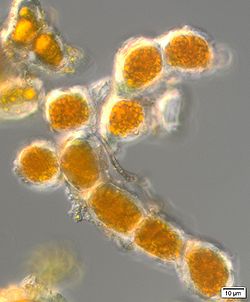 Trentepohlia cf. umbrina, a filamentous alga from tree bark; Nipmuck trail south of Rt. 171, Union, CT |
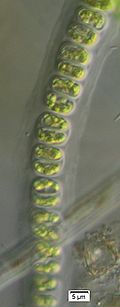 Geminella ellipsoidea, Cedar Swamp, Mansfield, CT |
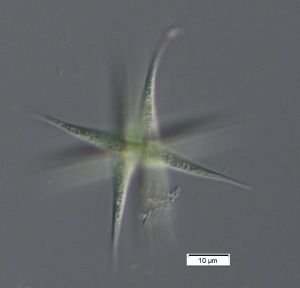 Ankistrodesmus falcatus, a colonial alga from Breakneck Pond, Union, CT |
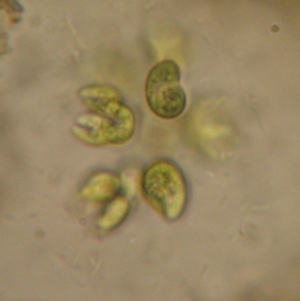 Kirchneriella lunaris, a colonial alga from Breakneck Pond, Union, CT |
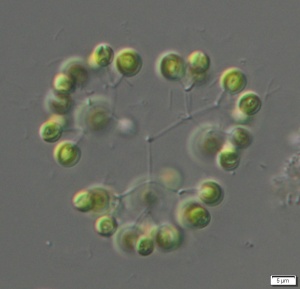 Dictyosphaerium pulchellum, a colonial alga from wetland on Mansfield City Rd., Eagleville, CT |
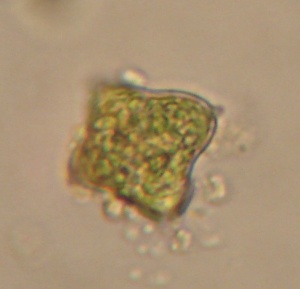 Tetraedron regulare from wetland on Mansfield City Rd., Eagleville, CT |
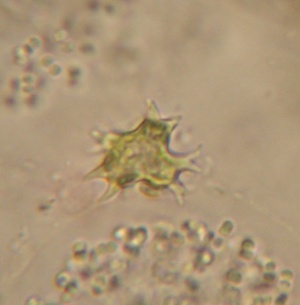 Tetraedron enorme from wetland on Mansfield City Rd., Eagleville, CT |
- Some green algae form colonies with defined numbers of cells (4, 8, 16, etc.). Such colonies are called coenobia. Commonly found coenobial green algae are Pediastrum, Stauridium, Coelastrum, Desmodesmus, and Scenedesmus from the order Sphaeropleales. Their sister order Volvocales also contains several coenobial representatives, for example: Eudorina, Pleodorina, Pandorina, and Volvox.
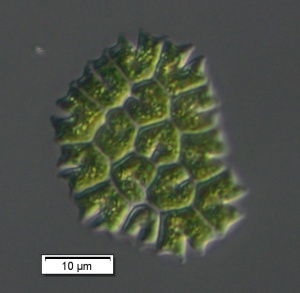 Stauridium tetras from pond on Forest Rd., Mansfield, CT |
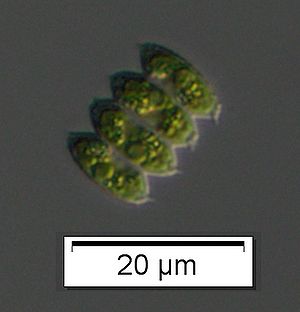 Desmodesmus denticulatus from pond on Forest Rd., Mansfield, CT |
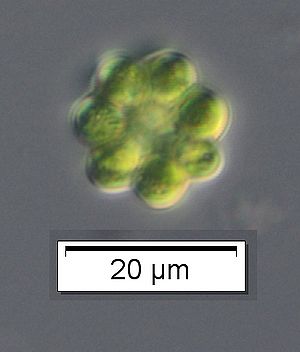 Coelastrum microporum from pond on Forest Rd., Mansfield, CT |
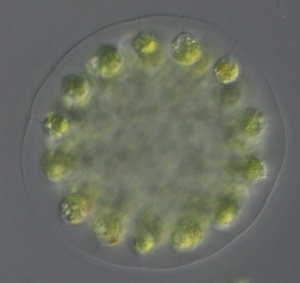 Eudorina elegans, a coenobium of flagellates from Breakneck Pond, Union, CT |
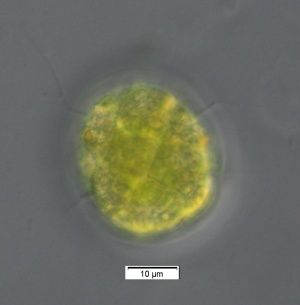 Pandorina morum, a coenobium of tightly packed flagellates from Breakneck Pond, Union, CT |
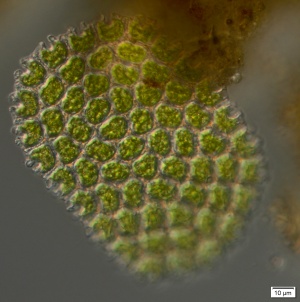 Pediastrum angulosum, a coenobial alga related to Stauridium, from Halls Pond, Chaplin, CT |
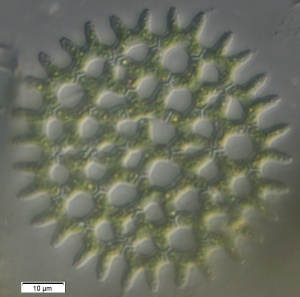 Pediastrum duplex, a coenobial alga related to Stauridium, from Breakneck Pond, Union, CT |
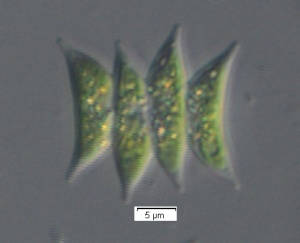 Scenedesmus acutus from Breakneck Pond, Union, CT |
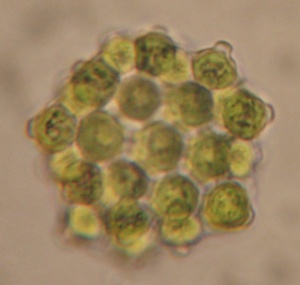 Coelastrum cambricum, a colonial alga from Breakneck Pond, Union, CT |
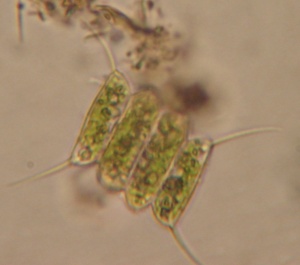 Desmodesmus quadricauda, a coenobial alga from River Park, Tolland, CT |
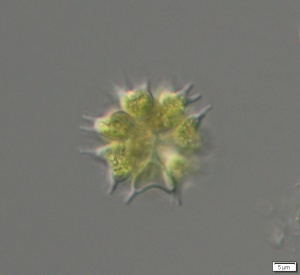 Sorastrum americanum from wetland on Mansfield City Rd., Eagleville, CT |
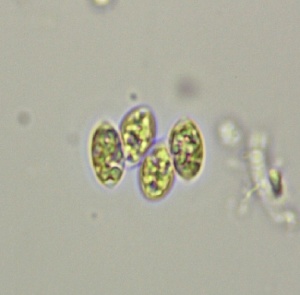 Another species of Scenedesmus from a tank in the EEB greenhouse, Storrs, CT |
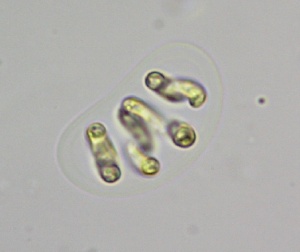 Nephrocytium agardhianum, a colonial alga from the EEB greenhouse, Storrs, CT |
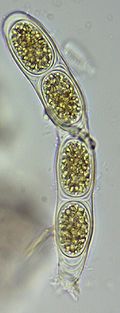 Cylindrocapsa geminella, a filamentous alga from the EEB greenhouse, Storrs, CT |
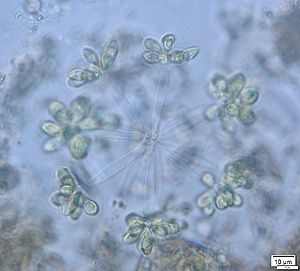 Actidesmium hookeri, a colonial green alga from Shenipsit Lake, Ellington, CT |
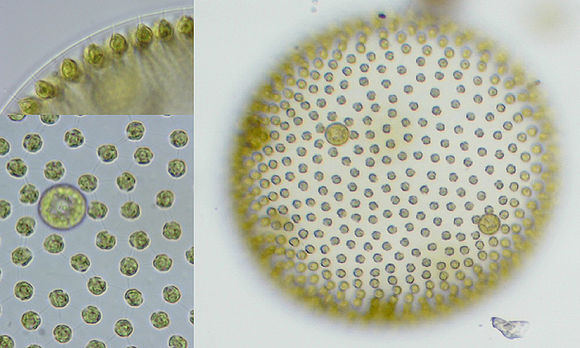 Volvox aureus, a coenobial alga from a tank in the EEB greenhouse, Storrs, CT; details of the coenobium including connections between cells are shown in close-up insets |
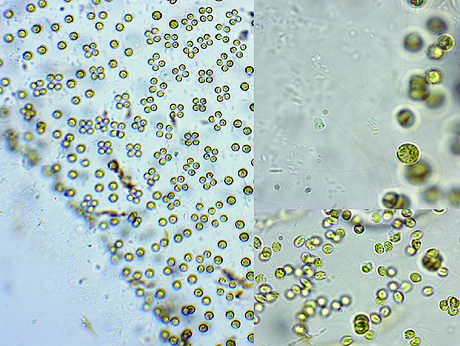 Tetraspora gelatinosa, a colonial alga from the stream by N. Lyon Memorial Park, Eastford, CT; detail on colony edge with non-funcional pseudocilia (top inset) and motile flagellated zoospores (bottom inset); video of swarmers here: https://youtu.be/fAVwsG5zHoo |
Green algae: Streptophyta
Conjugating green algae (Zygnemophyceae)
Desmidiales
- The order Desmidiales contains some of the most spectacular of algae. Many species of the crescent-shaped Closterium can be found in the Northeast, as well as Cosmarium, Staurastrum, Euastrum, Micrasterias, Xanthidium, and others.
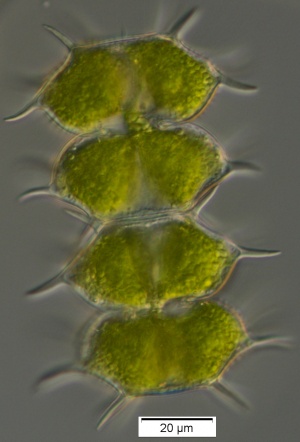 Xanthidium antilopaeum from pond on Forest Rd., Mansfield, CT |
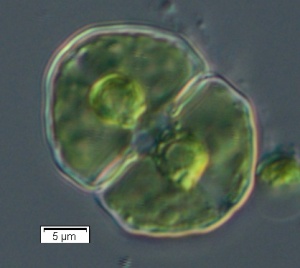 Cosmarium sp. from the EEB greenhouse, Storrs, CT |
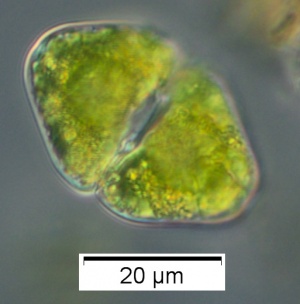 Cosmarium granatum from pond on Forest Rd., Mansfield, CT |
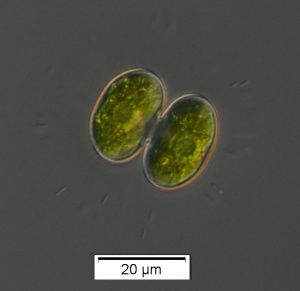 Cosmarium contractum from pond on Forest Rd., Mansfield, CT |
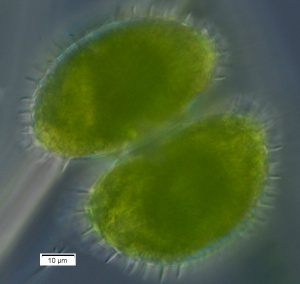 Staurastrum cf. hirsutum from stream by the Willington Pizza restaurant, Willington, CT |
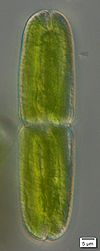 Tetmemorus brebissonii from a marsh at Bigelow Hollow, Union, CT |
 Tetmemorus granulatus from a marsh at Bigelow Hollow, Union, CT |
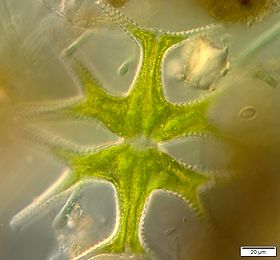 Micrasterias mahabuleshwarensis var. ringens from Halls Pond, Chaplin, CT |
 Onychonema laeve from Halls Pond, Chaplin, CT |
 empty cell walls of Spondylosium luetkemuelleri from Halls Pond, Chaplin, CT |
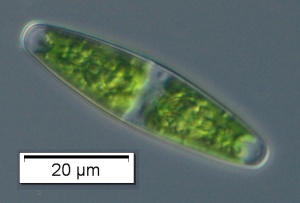 Closterium navicula from pond on Forest Rd., Mansfield, CT |
 Cosmarium denticulatum from pond on Forest Rd., Mansfield, CT |
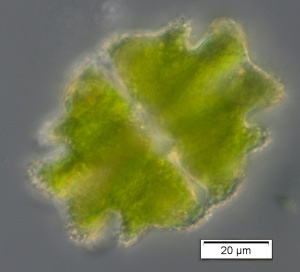 Euastrum verrucosum from pond on Forest Rd., Mansfield, CT |
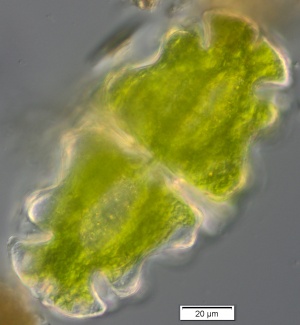 Euastrum cf. oblongum from pond on Forest Rd., Mansfield, CT |
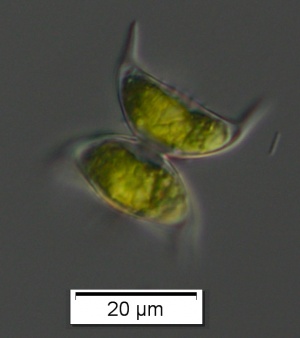 Staurodesmus dejectus from pond on Forest Rd., Mansfield, CT |
 Closterium cf. kuetzingii from pond on Forest Rd., Mansfield, CT |
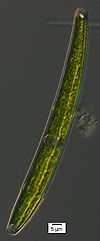 Closterium sp. from pond on Forest Rd., Mansfield, CT |
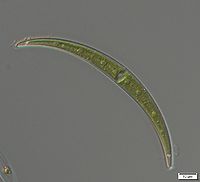 Closterium parvulum from wetland on Mansfield City Rd., Eagleville Rd., CT |
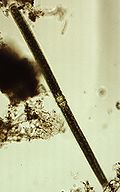 Pleurotaenium trabecula from Knowlton Pond, Ashford, CT |
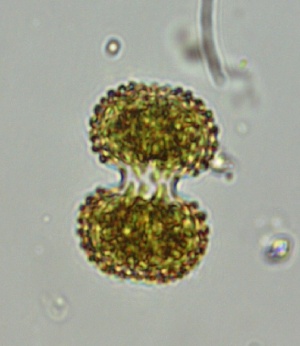 Cosmarium portianum from Barrows Academy Pond, Windham, CT |
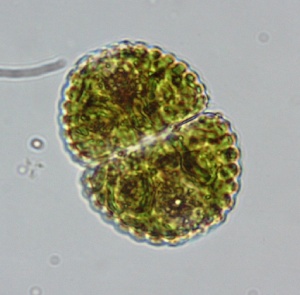 Cosmarium speciosum from Barrows Academy Pond, Windham, CT |
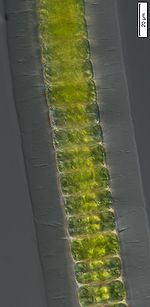 Hyalotheca dissiliens, a filamentous desmid from Cedar Swamp/Rt. 195, Mansfield, CT |
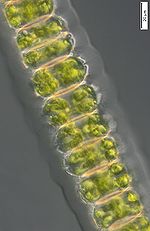 Desmidium grevillei, a filamentous desmid from Cedar Swamp/Rt. 195, Mansfield, CT |
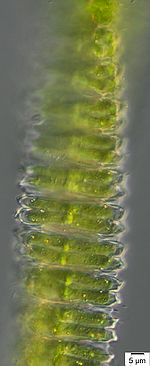 Desmidium swartzii, a filamentous desmid from Breakneck Pond, Union, CT |
 Spondylosium cf. pulchrum, a filamentous desmid from Breakneck Pond, Union, CT |
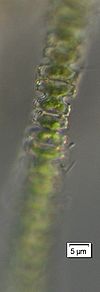 Teilingia sp., a small filamentous desmid from Breakneck Pond, Union, CT |
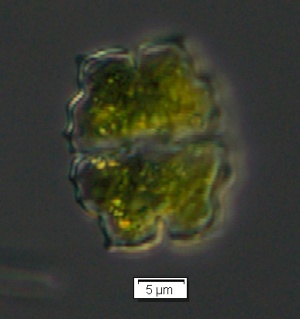 Euastrum cf. pulchellum from pond on Forest Rd., Mansfield, CT |
 Euastrum binale from Breakneck Pond, Union, CT |
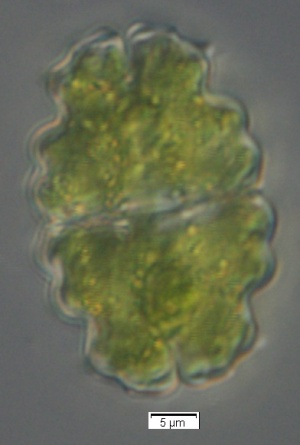 Euastrum bidentatum from Breakneck Pond, Union, CT |
 Euastrum affine from Breakneck Pond, Union, CT |
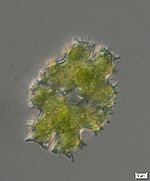 Euastrum denticulatum from wetland on Mansfield City Rd., Eagleville, CT |
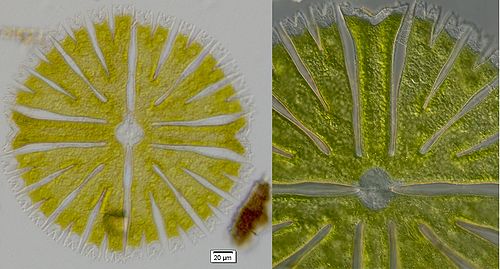 Micrasterias radiosa, a large desmid from Breakneck Pond, Union, CT |
 Micrasterias truncata from Breakneck Pond, Union, CT |
 Micrasterias laticeps from Breakneck Pond, Union, CT |
 Pleurotaenium nodosum from Breakneck Pond, Union, CT |
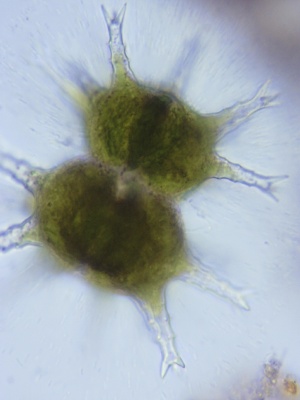 Staurastrum arctiscon from Knowlton Pond, Ashford, CT |
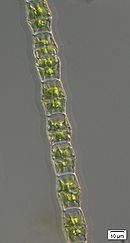 Bambusina brebissonii from wetland on Mansfield City Rd., Eagleville, CT |
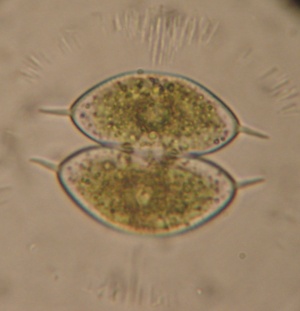 Staurodesmus convergens from Breakneck Pond, Union, CT |
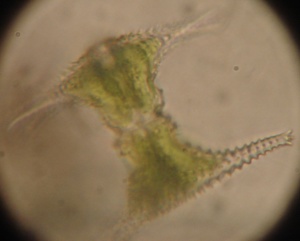 Staurastrum cf. ophiura from Breakneck Pond, Union, CT |
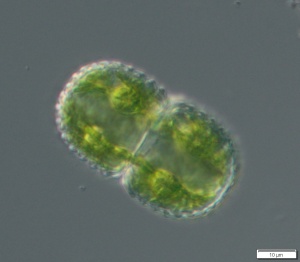 Cosmarium amoenum from Breakneck Pond, Union, CT |
 Micrasterias denticulata from Bigelow Pond, Union, CT |
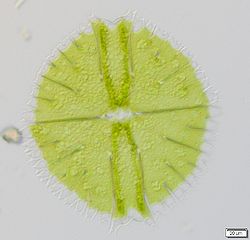 Micrasterias rotata from Breakneck Pond, Union, CT |
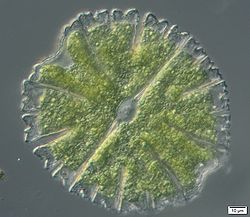 Micrasterias rotata var. japonica from Breakneck Pond, Union, CT |
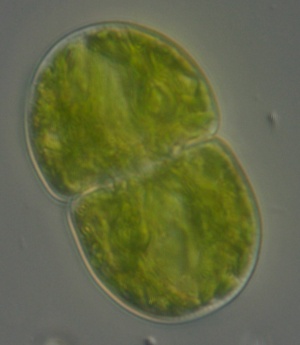 Cosmarium subcucumis from Bigelow Pond, Union, CT |
 Xanthidium cristatum from Pine Acres Lake, Chaplin, CT |
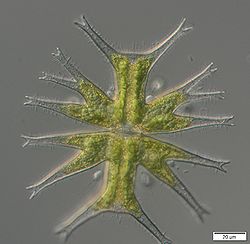 Micrasterias radiata from wetland on Mansfield City Rd., Eagleville, CT |
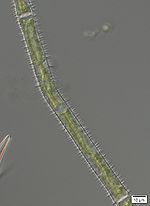 Gonatozygon aculeatum from wetland on Mansfield City Rd., Eagleville, Union, CT |
 MIcrasterias pinnatifida from wetland on Mansfield City Rd., Eagleville, CT |
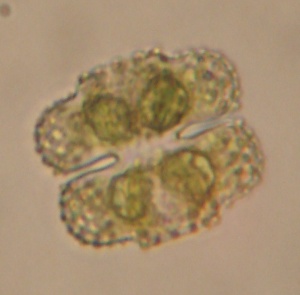 Cosmarium comminsurale from wetland on Mansfield City Rd., Eagleville, CT |
 Staurastrum cf. teliferum from wetland on Mansfield City Rd., Eagleville, CT |
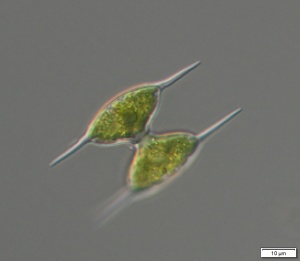 Staurodesmus subulatus from wetland on Mansfield City Rd., Eagleville, CT |
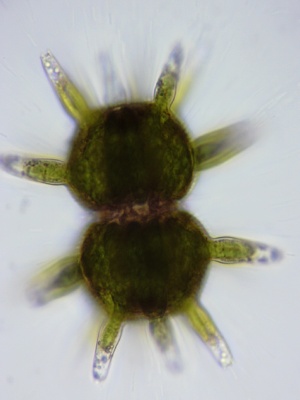 Staurastrum wolleanum from Knowlton Pond, Ashford, CT |
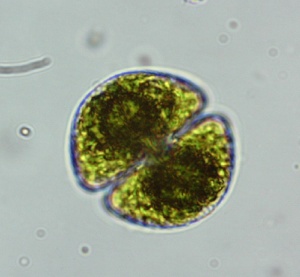 Staurastrum orbiculare from Barrows Academy Pond, Windham, CT |
Zygnematales
- The order Zygnematales contains commonly occurring ("weedy") filamentous taxa Zygnema, Mougeotia, and Spirogyra, but also several unicellular genera, for example Netrium or Spirotaenia.
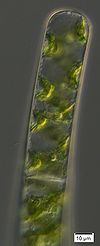 Spirogyra sp. from stream by the Willington Pizza restaurant, Willington, CT |
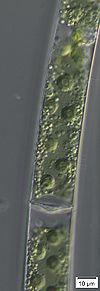 Mougeotia sp. from Cedar Swamp/Rt 195, Mansfield, CT |
 Netrium digitus from Breakneck Pond, Union, CT |
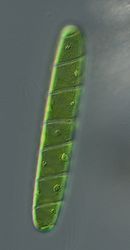 Spirotaenia condensata from Breakneck Pond, Union, CT |
other Streptophyte classes
- Klebsormidiales are a group of inconspicuous but commonly occurring filamentous algae.
- Coleochaetales are among the closest relatives of land plants. Some species retain and nourish the fertilized zygote (this is called matritrophy) and form disc-like thalli (bodies) that often grow attached to aquatic plants or other substrates.
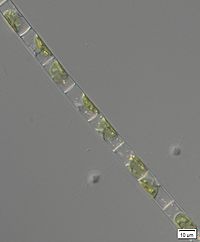 Klebsormidium sp. from Halls Pond, Chaplin, CT |
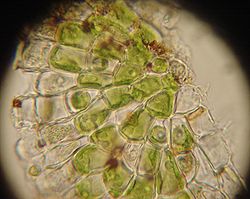 Coleochaete scutata from Bigelow Pond, Union, CT |
- Not all algae are microscopic. Aside from the conspicuous marine seaweeds, several freshwater algae are also observable by the naked eye. The green algae of the class Charophyceae (stoneworts) can be found in many water bodies in the Northeast, but can be easily mistaken for aquatic plants.
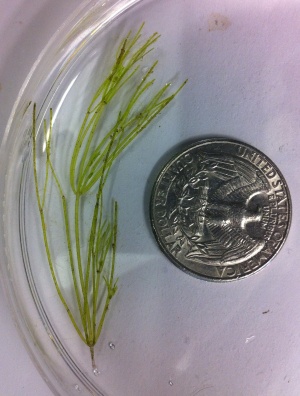 Nitella flexilis from Walker Reservoir East, Vernon, CT |
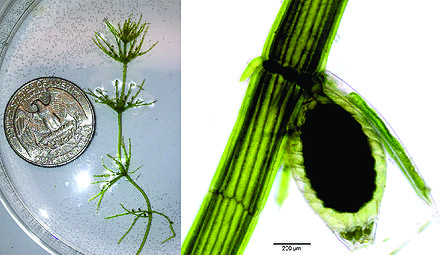 Chara zeylanica from the EEB greenhouse, Storrs, CT, and a closeup of its reproductive structure (oospore) |
- And let's not forget the most famous lineage of Streptophyta - land plants!
| |
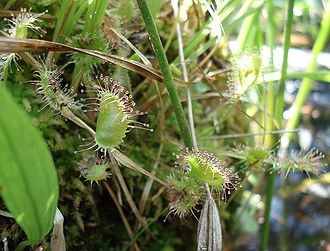 sundew - a carnivorous plant, growing on a stump |
 Breakneck Pond, Union, CT |









